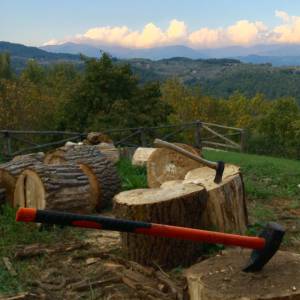Degrees of separation
My decanting of the hard won olive oil baffles me. The extract from the press separates into a column of three substances: a thin top layer of purish oil, a thicker layer of oil gel with olive solids in suspension and a bottom layer of vegetable water.
Reading more about processing olives it seems that talc (from the Persian ‘talk’) has been used as an additive in virgin olive oils since the 1970s. It helps to reduce the water content of the crushed olive paste and is useful for the separation of the oil from the olive gel and thus shortens the process of centrifuging and increases the yield of oil.
It is added either to the raw olives after washing or to the paste after grinding at between 0.3 and 1.0 per cent of the weight of olives and is extracted at the first centrifuge. Imerys, who bought up Cornish China clear years back, sell a product called Talcoliva.
Further reading of the Italian agri press tells me that the olive harvest this year is characterised thus far (Puglia is not yet harvesting) by low aggregate yield - 10% - as compared to an average of 15%. That is a third less than normal- a reduction from 150 litres from a metric tonne Of olives to 100 litres.
This has been caused by the vagaries of the autumn weather. September is the key month for ‘inolizione’ - the production of oil within the olive’s cells. But September was too hot and too dry. This was followed in a really sudden transition to cold wet weather ( which has also ruined the autumn porcini season).
So the oil content of the olives is low and the water content high - normally 50% but this year - depending on time of harvest - more like 65%. Apparently olives will take up water hours after rainfall but it takes 5 to 7 days for the water content to fall towards 50%.
The weather and fear of the depredations of the olive fly has led to harvesting taking place 15 days sooner than normal.
This tends to give a greener, spicier oil that can verge of the unpleasantly bitter.
I find all of this strangely reassuring although around here I think people are holding out for better weather before harvesting although I suspect that boat may have sailed. For optimum oil production min/max temps need to be not below 10C and not above 18C. Our nights have been considerably colder.
Anyway, if I had a pinch of pure inert unadulterated talc I’d mix it into my gel/oil to see if this would separate the water, solids and oil. Lacking that I might have to build a centrifuge - a strimmer has a pretty good RPM.
One of the things I’ve learnt from all this is that the olive is a delicate living thing. I know it’s obvious but on the tree they seem an obdurate invulnerable thing: the fruits hard and bitter, like bullets; the leaves scaly and scratchy. Maybe this perception also come from seeing and eating inert pickled olives.
But to make good oil with all its health enhancing qualities requires knowing when to harvest and ensuring milling takes place quickly to minimise oxidation that starts as soon as the olives are detached from the living tree. During milling contact with light and air quickly reduces the quality of the oil and while heating and dilution with water can increase yields they also drive or drain off the delicate phenols and antioxidants.
There are clearly a lot of compromises and choices to be made and much depends on the price/ quality ratio a producer can secure in the market. My experience suggests a single estate oil from Tuscany sells for between 15-20€ for a 750cl bottle. We can get good Tuscan oil for 10€ a litre. Italian oil sells for 7-10€ a litre and then prices go lower for EC blended and bulk Spanish oils.
Virgin olive oil simply means it is produced at below 27C by mechanical means and does not use active chemicals like hexane to release the oil although this does not exclude the use of inert talc.

Comments
Sign in or get an account to comment.


